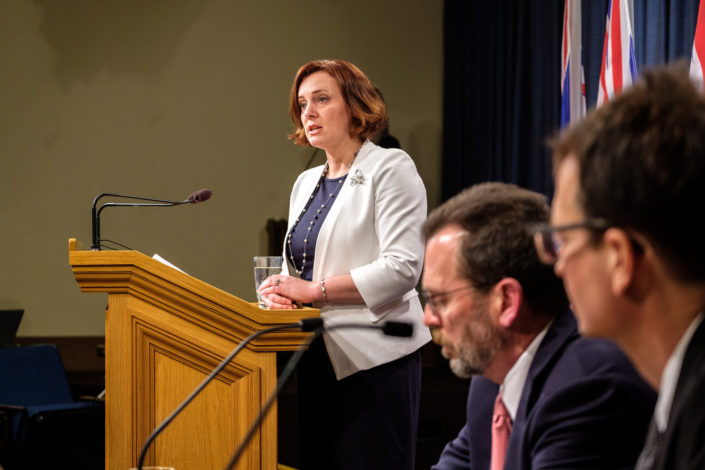Zapped: Unravelling the NDP’s new spin around power prices and the Site C dam
B.C.'s NDP is now doing precisely what it criticizes the Liberals for doing — manufacturing a need for power while pushing forward with a project that produces energy that can’t be sold for even close to the price it will cost to produce it.
By Sarah Cox, for The Narwhal
Of all the years of political spin to justify construction of the Site C dam, last week’s media briefing about BC Hydro might get a special place in the hall of fame.
On Thursday, provincial media were invited to the underground theatre at the B.C. Legislature for a “technical briefing” on the first phase of a review of BC Hydro, a public utility so deeply indebted that it’s been flirting with bankruptcy.
For the next 30 minutes or so, media were treated to a shock and awe presentation with a barrage of slides, graphs, numbers and various claims about B.C.’s energy demand and the price of different renewables.
It all bolstered the NDP government’s messaging, rolled out the previous evening in an exclusive story placed in the Vancouver Sun, that contracts the previous Liberal government signed with independent power producers have led to staggering losses for BC Hydro and that the Liberals had manufactured a need for new power.
“The reason Site C is something we are going to need in the future is because it’s firm power,” B.C. Energy Minister Michelle Mungall nevertheless told the Sun in an interview that accompanied the story about the government’s report on independent power projects (IPPs), titled Zapped.
The IPP contracts, Mungall informed media after the technical briefing, were a “sweetheart deal for some” but not a good deal for British Columbians who had “overpaid billions of dollars for power.”
How ironic then, that the NDP government opted for a sweetheart deal for itself when it announced just over a year ago that construction of the Site C dam would continue.
It punted the question of how to pay for the project’s unsightly $10.7 billion tab to a future government, passing the buck to generations of future hydro customers while appeasing its construction trades union donors that had lobbied relentlessly for construction to proceed.
The result is that the NDP is now doing precisely what its report justifiably criticizes the Liberals for doing with IPPs — manufacturing a need for Site C’s power while saddling generations of British Columbians with a project which will produce energy that cannot be sold for even close to the price it will cost to produce it.

Construction on the Site C dam in the summer of 2018. Photo: Garth Lenz / The Narwhal
In January, the conservative C.D. Howe Institute issued a report outlining why Site C — along with the Keeyask dam in Manitoba — is “uneconomical” and should be terminated immediately.
“For projects like Site C and Keeyask, it is not too late to cancel,” said the report, Dammed If You Do: How Sunk Costs Are Dragging Canadian Electricity Ratepayers Underwater.
“The sooner provinces face reality and begin negotiating reasonable cancellation programs, the better off ratepayers will be.”
But now the NDP is recharging efforts to convince British Columbians that Site C’s power is needed and that the troubled project is a bargain, even though the dam’s cost has soared by more than $4 billion since it was announced in 2010 and, according to an independent review, could exceed $12.5 billion.
In 2017, the independent B.C. Utilities Commission concluded that a renewables portfolio, including wind and geothermal, could supply the equivalent power of Site C for $8.8 billion or less, calling BC Hydro’s energy forecasts “excessively optimistic.”
Those forecasts have been wrong for years, according to the Commercial Energy Consumers Association, which represents the province’s commercial sector and business interests. Power demand in the province has been stagnant since 2005, despite a growing population.
To fortify its case for the Site C dam, the NDP government mysteriously dropped the price of Site C power at the technical briefing, thus casting the project in a favourable light compared to other renewables, including independent power projects that could be a good deal for British Columbians.
Instead of costing $83 per megawatt hour, as BC Hydro stated when the Site C dam cost $2 billion less than it does now, Site C’s energy can now supposedly be produced for just $62 per megawatt hour, according to the technical briefing.
Wind power, on the other hand, costs between $70 to $105 per megawatt hour to produce in B.C., journalists were informed — which is odd indeed, because the Alberta government recently bought wind power for $37 per megawatt hour and wind power with storage is selling in the U.S. for US$21 per megawatt hour.
When asked about the discrepancy, the senior civil servants — who can’t be named, according to the rules of the technical briefing — said it was because B.C.’s mountainous terrain makes wind power much more expensive than in other jurisdictions.
Tell that to the Canadian Wind Energy Association, which pulled out of B.C. in 2016 as the Site C dam proceeded. Tell that to Northland Power, which recently constructed the North Sea’s largest offshore wind farm but, as Site C continued, withdrew from two proposed wind projects in B.C., one near Prince George and the other near Summerland, that had the combined capacity to produce half as much power as Site C.
And tell that to First Nations all over B.C. who are eager to join the global renewables revolution but who were shut out by the decision to proceed with the Site C dam — First Nations that had already invested in plans for clean energy projects were told last week that BC Hydro’s standing offer program was not just on hold but cancelled, because B.C. doesn’t need one more watt of power.
And then there’s solar energy. Solar just isn’t a good option for B.C., according to the senior bureaucrats at the technical briefing.
Yet the United Kingdom, not known for excessively sunny weather, has installed enough solar capacity to generate more than twice the amount of Site C’s energy.
A provincial government study found that northeast B.C., where the Site C dam will be built on the Peace River, is ideal for solar. Witness the town of Hudson’s Hope in the district that will be most severely affected by the Site C dam, which recently installed B.C.’s largest municipal solar array and will save an estimated $70,000 a year on its hydro bills as a result.
Curious, too, that BC Hydro recently changed the rules for people who install solar at their own expense.
Unlike other utilities, BC Hydro no longer wants to buy extra power from new solar installations — power the utility has purchased for about $100 per megawatt hour. Granted, those purchases alone don’t add up to anywhere near as much power as Site C would produce, but the price is a steal of a deal compared to Site C’s power, which experts like Eoin Finn, a former partner with the global accounting firm KPMG, peg at $120 or more per megawatt hour.
And let’s not forget that BC Hydro backed away from its energy conservation programs as Site C moved forward — programs that, according to BC Hydro’s former CEO and president, had saved about as much power as Site C will produce.
All the more puzzling, B.C. refuses to follow other jurisdictions and introduce time-of-use tariffs, which would further reduce energy demand.
As for Mungall’s claim that B.C. needs Site C because it is “firm” power, readily available any time, the vast majority of B.C.’s energy currently comes from non-run of river hydro.
That means we already have oodles of firm power, including from the W.A.C. Bennett dam, where water flows into the Peace River have been held back for several years for Site C construction — with the only harm done not to energy supply during cold snaps and heat waves but to Wood Buffalo National Park.
There’s also the “firm” Columbia River power, even more power than Site C would produce, that B.C. sells to the United States. The price the U.S. pays for that power? About $30 per megawatt hour.
But U.S. president Donald Trump thinks $30 per megawatt hour is far too high a cost, and his government has re-opened Columbia River Treaty negotiations in an effort to reduce it.
BC Hydro also has the option of using existing assets like the sixth generating unit at the Revelstoke Generating Station (Revelstoke 6) for additional firm power, if indeed it is ever needed.
Just over a year ago, B.C.’s NDP government said a taxpayer bailout of Site C’s $2 billion in sunk costs would result in “massive cuts to services” on which British Columbians depend (a claim that was immediately slammed by project financing experts and later revealed by The Narwhal to be something of a sham).
Yet on Thursday, the government announced a BC Hydro bailout of $1.1 billion with — wait for it — no cuts to services.
An eight per cent rate hike over five years is now on offer from the NDP — provided the utilities commission accepts the government’s suggestion that eight per cent is sufficient to cover BC Hydro’s rising costs, let alone to start paying down Hydro’s remaining $4.4 billion debt.
Nor has the NDP ruled out another bailout for BC Hydro.
None of those initiatives, however, will pay for the Site C dam, the astronomical bill for which will only start to come due in approximately five years when the power comes on-line.
The C.D. Howe report takes aim at the NDP government’s assertion that it has no choice but to continue building the Site C dam due to the amount of money that had already been spent.
“Policymakers often justify proceeding with uneconomic projects due to the significant amount of money that has already been spent,” the report’s authors note, a phenomenon known as the “sunk cost fallacy.”
“However, the decision about whether to proceed with a project should be determined by the yet-to-be-spent costs, instead of costs already spent.”
The authors recommend that B.C. and Manitoba consider hiring skilled negotiators to “review all existing contracts and develop a pathway toward minimizing cancellation costs, identifying ways to recover value and exploring means of appropriately compensating key stakeholders such as First Nations.”
Even now, a combination of energy sources such as wind and natural gas, including projects with storage capacity “procured in smaller sizes closer to the period of demonstrated need, would be more cost-effective” than the Site C dam, the report concludes.
In Manitoba, an inquiry is now underway to determine why work continued on the hugely over-budget Keeyask dam even though its energy wasn’t needed. Ironically, that inquiry is being led by former B.C. premier Gordon Campbell, who was so determined to build the Site C dam that his government changed the law to remove the B.C. Utilities Commission from determining if the project was in the financial interests of British Columbians.
Likewise, in Newfoundland, a $37.5 million public inquiry is underway into the boondoggle Muskrat Falls dam on Labrador’s Churchill River. Residents of Newfoundland and Labrador can go online to determine how much their hydro bills will rise because of the ill-sighted dam, with an average $1,800 a year per household reported.
Why did the Crown corporation Nalcor continue building the Muskrat Falls dam, and why did the provincial government let it? Where was the oversight and where were the missed opportunities to stop the project before it was too late? Who manufactured the need for Muskrat Falls energy, and why? What other energy options were available if the need arose? Who knew what, and when?
Those are just some of the questions the inquiry is probing — the same questions that no doubt will be asked one day at the inevitable, and much anticipated, Site C dam inquiry in B.C.


























Comments